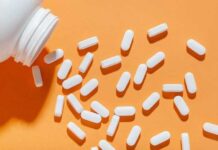
Those struck with Parkinson’s Disease, a condition of the nervous system, will suffer a slow progression of debilitating symptoms throughout the remainder of their lives. Scientists are actively seeking remedies—some of which have been found in Chinese herbs—to ease symptoms and improve the quality of life for Parkinson’s patients.
In three separate scientific studies, the ancient Chinese herb gou teng, also known as cat’s claw (Uncaria rhynchophylla), has been shown to improve the symptoms associated with Parkinson’s disease.
A total of 60 patients participated in the study, with 30 taking the herbal formula and 30 in the placebo group. Each took either the herbs or a placebo three times a day for twelve weeks. The researchers found that the herbs effectively improved sleep dysfunction in the Parkinson’s patients and that the improvements lasted an additional four weeks after completion of the study.
Another Chinese clinical study set out to assess the effects of gou teng on Parkinson’s patients. The study included 55 patients who were randomized to take either an herbal formula that included gou teng or a placebo for twenty-four weeks. The study found that the group taking the herbal formula slept better and had more fluent speech than the group taking the placebo.
In a third study published in Scientific Reports, a popular Chinese herbal formula commonly used to treat the symptoms of Parkinson’s disease which includes gou teng was found to increase the survival rate, improve impaired locomotor function and alleviate apoptotic cell death in the rats studied. The formula also demonstrated neuroprotective properties both in vitro (outside the living body and in an artificial environment) and in vivo (in the living body of a plant or animal).
Parkinson’s Disease
Parkinson’s disease is a neurodegenerative disorder, and according to the Parkinson’s Foundation, affects more than 10 million people worldwide. The disease primarily affects nerve cells in a part of the midbrain called the substantia nigra, responsible for muscle movement. The degeneration of these nerve cells results in a reduction of the neurotransmitter dopamine, causing tremors, difficulties with balance, slow movements, and rigidity.
Present treatments for Parkinson’s include medications that help increase dopamine levels in the brain, which help control the disease’s symptoms. One of the most common drugs for Parkinson’s is levodopa which is absorbed by nerve cells in the brain and turned into dopamine. Dopamine is a neurotransmitter that is used to transmit messages between parts of the brain and the nerves that control movement.
Gou Teng and Parkinson’s Disease
The way that gou teng is thought to stabilize Parkinson’s symptoms has been explored by Li Min, a doctor of Chinese medicine, and was discussed in a 2011 article in New Scientist. Li Min, associate dean of Chinese medicine and the director of the Mr. & Mrs. Ko Chi Ming Centre for Parkinson’s Disease Research at Hong Kong Baptist University, and her team were looking into the effect of gou teng on Parkinson’s symptoms.
Parkinson’s symptoms like tremors, rigidity, and difficulty with muscle movement are caused by the progressive deterioration of the cells in the brain that produce dopamine, and previous research has suggested that the excess of a protein called alpha-synuclein may be the culprit. Current treatments for Parkinson’s focus on boosting levels of dopamine, which only partially alleviates symptoms, and does not affect these proteins, which gather in clusters. It is thought that the proteins accumulate into clusters because the brain is not able to remove them effectively through a process called autophagy—a type of programmed cell death. It was observed that mice without the genes needed for autophagy rapidly developed Parkinson’s-like symptoms.
According to Li, autophagy is the only known process that clears out abnormal proteins within cells. “Enhancing this pathway may be the key to treating Parkinson’s,” she says in the article.
Li’s team searched gou teng for active compounds, testing which ones could increase the rate of autophagy to remove the alpha-synuclein clusters. One of the compounds they isolated—an alkaloid called isorhy—stimulated autophagy for alpha-synuclein at a similar rate as the drug rapamycin. Rapamycin is a drug usually used to suppress the immune system in patients receiving organ transplants but has been recently suggested as a candidate for Parkinson’s treatment because it prevents nerve cell death in flies with Parkinson-like disease. However, because it suppresses the immune system, it would have serious side effects for people with Parkinson’s, whereas gou teng has been used for millennia and is considered extremely safe.
After further testing, Li and her colleagues found that isorhy induced autophagy via a different pathway than rapamycin, which may explain why it doesn’t have the same effect on the immune system. Further research is needed, but these findings uncover an exciting clue as to the mechanisms by which gou teng may improve Parkinson’s symptoms.
Gou Teng/Cat’s Claw (Uncaria rhynchophylla)
In Chinese medicine, gou teng is a class of herbs that extinguish wind and stop tremors and has been used for this purpose for more than 2,000 years. Gou teng belongs to the Rubiaceae family and is also known as uncaria vine and gambir. The plant grows as a woody vine that has hooked, claw-shaped thorns that resemble a cat’s claws. Gou teng is used in Chinese medicine to treat the “shakes” associated with conditions like Parkinson’s disease and is also used to treat liver conditions that can lead to high blood pressure, as studies are now showing.
Wind in Chinese Medicine
Gou teng particularly affects the liver, which is seen as the source of internal wind in Chinese medicine. Although this isn’t the type of wind that you find outside, blowing through the tree branches or scattering a freshly raked pile of leaves, it shares the same characteristics within the body.
Wind, in the Chinese medicine concept, is used to describe specific characteristics inside the body, namely, its disordered, erratic, and uncontrolled nature. Exterior wind also exists in Chinese medicine, but is different as it comes from external climatic conditions, and can, like internal wind, contribute to illness. The internal wind has the characteristics of erratic movement, tremors, stiffness, and increasing problems controlling the body’s movements. This internal wind can come about for various reasons, but in cases of Parkinson’s disease, it is commonly due to a blood deficiency.
In Chinese medicine, blood deficiency is seen to be a lack of vital fluids that keep the muscles and tendons moistened and nourished ensuring strong muscles and smooth movements. Blood deficiency is a condition commonly seen in the elderly, and Parkinson’s disease is most commonly diagnosed after age sixty.
Final Thoughts
Chinese medicine contains an enormous reservoir of knowledge about the healing abilities of plants, animals, and minerals and was created over thousands of years of research and development. Many of the theories and practices of Chinese medicine don’t easily translate to the West, where we use a different paradigm to explain the inner workings of the body and the etiology of disease. But as science continues to validate this ancient wisdom, we stand to gain considerable knowledge about the healing potential of herbs, and the ability to help more people suffering from the health conditions that affect us all.
Important Notice: This article was originally published at www.theepochtimes.com by Emma Suttie D.AC, AP where all credits are due.
Disclaimer
The watching, interacting, and participation of any kind with anything on this page does not constitute or initiate a doctor-patient relationship with Dr. Farrah™. None of the statements here have been evaluated by the Food and Drug Administration (FDA). The products of Dr. Farrah™ are not intended to diagnose, treat, cure, or prevent any disease. The information being provided should only be considered for education and entertainment purposes only. If you feel that anything you see or hear may be of value to you on this page or on any other medium of any kind associated with, showing, or quoting anything relating to Dr. Farrah™ in any way at any time, you are encouraged to and agree to consult with a licensed healthcare professional in your area to discuss it. If you feel that you’re having a healthcare emergency, seek medical attention immediately. The views expressed here are simply either the views and opinions of Dr. Farrah™ or others appearing and are protected under the first amendment.
Dr. Farrah™ is a highly experienced Licensed Medical Doctor certified in evidence-based clinical nutrition, not some enthusiast, formulator, or medium promoting the wild and unrestrained use of nutrition products for health issues without clinical experience and scientific evidence of therapeutic benefit. Dr. Farrah™ has personally and keenly studied everything she recommends, and more importantly, she’s closely observed the reactions and results in a clinical setting countless times over the course of her career involving the treatment of over 150,000 patients.
Dr. Farrah™ promotes evidence-based natural approaches to health, which means integrating her individual scientific and clinical expertise with the best available external clinical evidence from systematic research. By individual clinical expertise, I refer to the proficiency and judgment that individual clinicians acquire through clinical experience and clinical practice.
Dr. Farrah™ does not make any representation or warranties with respect to the accuracy, applicability, fitness, or completeness of any multimedia content provided. Dr. Farrah™ does not warrant the performance, effectiveness, or applicability of any sites listed, linked, or referenced to, in, or by any multimedia content.
To be clear, the multimedia content is not intended to be a substitute for professional medical advice, diagnosis, or treatment. Always seek the advice of your physician or other qualified health providers with any questions you may have regarding a medical condition. Never disregard professional medical advice or delay in seeking it because of something you have read or seen in any website, video, image, or media of any kind. Dr. Farrah™ hereby disclaims any and all liability to any party for any direct, indirect, implied, punitive, special, incidental, or other consequential damages arising directly or indirectly from any use of the content, which is provided as is, and without warranties.








